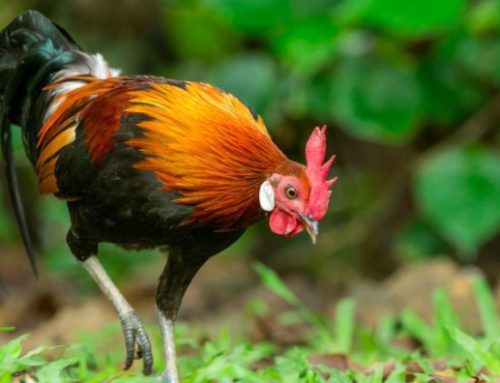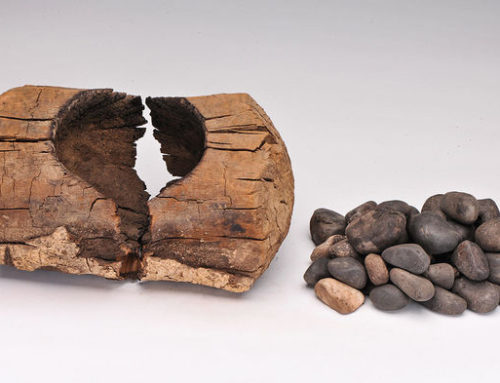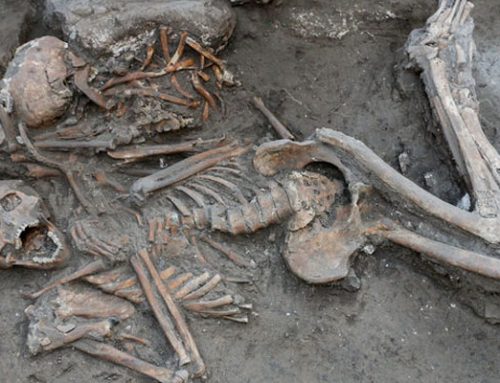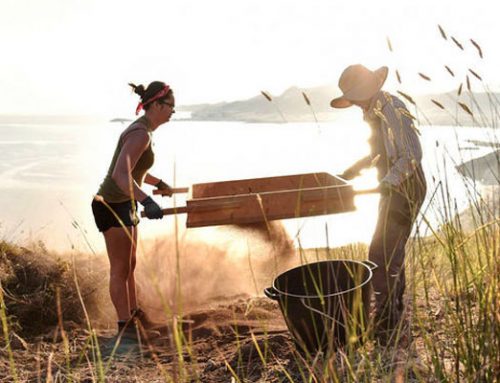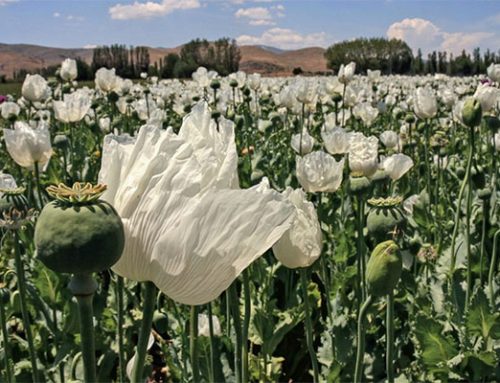
“One day, the old desire entered my head to visit far countries and strange people, to voyage among the isles and curiously regard things hitherto unknown to me,” recalls Sinbad the Sailor in The Thousand and One Nights, first compiled in the 9th century C.E. “Also, the trading habit rose in me again.” This wily Odysseus of the Indian Ocean told fantastic stories of shipwrecks, cannibals, and exotic lands rich with gems and heady spices.
 Until recently, Sinbad’s tall tales held little interest for scholars of ancient and medieval East-West relations. They focused instead on the more than 6000-kilometer Silk Road far to the north, made famous by Venetian merchant Marco Polo, who traveled across the Central Asian steppes from Europe to China in the 13th century. Most researchers ignored the fact that Polo returned to Europe via the Indian Ocean, in the waters plied by real-world Sinbads. Glimpsed only in the odd Roman coin found in an Indian village or in medieval Chinese ceramics washed up on a Kenyan shore, the southern maritime road was easy to overlook.
Until recently, Sinbad’s tall tales held little interest for scholars of ancient and medieval East-West relations. They focused instead on the more than 6000-kilometer Silk Road far to the north, made famous by Venetian merchant Marco Polo, who traveled across the Central Asian steppes from Europe to China in the 13th century. Most researchers ignored the fact that Polo returned to Europe via the Indian Ocean, in the waters plied by real-world Sinbads. Glimpsed only in the odd Roman coin found in an Indian village or in medieval Chinese ceramics washed up on a Kenyan shore, the southern maritime road was easy to overlook.
Now, this busy trading route is emerging from the shadows. Researchers are picking through Southeast Asian swamps, diving off Sri Lankan reefs, and digging on African beaches. The artifacts they are finding—glass beads, potsherds, seeds, animal bones—reveal a lost story of Indian Ocean trade that went far beyond the simple exchange of gems and spices. “Finally we are moving beyond just talking about trade to the making of cultural identity,” says archaeologist and historian Himanshu Prabha Ray of New Delhi’s Jawaharlal Nehru University.
The work, still in the early stages, is shifting archaeologists’ focus from the great empires at either end of the Silk Road—Rome and China—to the trade and influence of the vibrant societies in between. Until recently, many historians would have agreed with a 20th century French scholar who dismissed the world’s third largest ocean as “scarcely more than an extension of the eastern Mediterranean.” A paucity of ancient texts and archaeological digs reinforced this parochial view.
But the new evidence shows that from 2000 B.C.E. until the arrival of Europeans in 1498, the Indian Ocean network linked diverse societies on three continents, catalyzing industrial development and cultural changes from early Southeast Asia to medieval coastal Africa. It all sounds unexpectedly modern, says J. D. Hill, an archaeologist at the British Museum in London. “The surprise is that the world was interconnected long ago.”
In 2008, archaeologist Nicole Boivin of the University of Oxford in the United Kingdom and colleagues won a $1.5 million, 5-year grant from the European Research Council to piece together the neglected history of Indian Ocean trade. They have since been expanding collaborations, applying new methods to existing artifacts, and conducting small digs around the rim of the ocean. Their ambitious goal is to track how plants, animals, trade goods, people, and ideas moved across the ocean over more than 3 millennia, and they shared progress reports at a November 2013 meeting in Oxford on protoglobalization in the region. Says archaeologist Greger Larson of Britain’s Durham University, with a touch of Sinbad swagger: “We are a new generation of explorers.”
Artisans Arrive: East Indian Ocean, 5th century B.C.E. to 2nd century B.C.E.

Tracing trade. At Khao Sam Kaeo, archaeologists discovered traces of an ancient city; 2000 kilometers away off Sri Lanka (right), divers examining a wreck found a pot from around 150 B.C.E.
PHOTOS: (LEFT TO RIGHT) BÉRÉNICE BELLINA-PRYCE; SUSANNAH H. SNOWDEN
The Indian Ocean is defined by the monsoon, an Arabic word for season. Blowing southwest from May to September and northeast from November to March, this wind reliably propels ships across large stretches of open sea. As early as 2000 B.C.E., Indian merchants traveled to Arabia on these winds, according to finds made in the 1980s (Science, 28 May 2010, p. 1101). Such ancient trade shaped the distribution of domesticated plants and animals: Grains like sorghum and millet made their way from Africa to India; zebu cattle went from India to Africa; and cinnamon and nutmeg moved from South Asia all the way to Israel and Egypt—although it is unclear who carried this bounty from continent to continent, and how. Now, a second phase of international trade, in the early centuries B.C.E., is coming to light in the eastern half of the ocean. In this period, India and China were urbanizing but Southeast Asia was long considered a rural backwater until its first empires arose, such as the Khmer empire based at Angkor Wat. Now, archaeologists are discovering that by 400 B.C.E., Southeast Asians were making iron, supporting an elite, and building large moated settlements of their own design, says Charles Higham of the University of Otago, Dunedin, in New Zealand, who has excavated extensively in Thailand and Cambodia. This new Southeast Asian elite would have prized luxury goods—and new finds suggest that trade with distant north India helped provide them. Between 2005 and 2009, a French-Thai expedition uncovered what may be the oldest known city in Southeast Asia, at the narrowest point of the Malay Peninsula that separates the Indian Ocean from the South China Sea. The site of Khao Sam Kaeo was an early and important trading link between India and Southeast Asia, argues Bérénice Bellina-Pryce, an archaeologist from the French national research agency CNRS in Paris who led the dig. Located 500 kilometers south of Bangkok, Khao Sam Kaeo is now a remote swamp. But millennia ago, it was a convenient point to unload goods from the Indian Ocean for overland transport to Southeast Asia (see map), avoiding a longer voyage through the treacherous, pirate-plagued Strait of Malacca to the south. The dig revealed that from the 4th century B.C.E. to the 1st century B.C.E., Khao Sam Kaeo was a sprawling city of walled neighborhoods surrounded by a ditch-and-palisade rampart. The finding was so unexpected that “it took me years to convince colleagues that we had an early form of urbanization,” Bellina-Pryce says. Later cosmopolitan coastal towns in this region probably resembled Khao Sam Kaeo. Working in dense forest and beset by looters, the team found metal vessels and stone and glass beads linking the site to India to the west and to Vietnam and China to the east. Bronze and iron workers at the site used copper alloys similar to those in Vietnam and China. But the beads, although made locally, were crafted using Indian technologies and imported glass (see sidebar), evidently by Indian artisans fashioning goods for Southeast Asian elites.
Higham, who was not involved in the research, concludes “the work at Khao Sam Kaeo has revealed beyond reasonable doubt that Indian craft workers were settling coastal port towns in the [Malay] peninsula by the 4th century B.C.E., and fashioning beads there for local tastes.” Indian cotton weavers were also likely hawking their wares in Southeast Asia in the early centuries B.C.E. The cotton has long since disintegrated, but the artisans left behind iron biconical spindle whorls, distinctive little objects with a hole in the middle and tapered on two sides. These whorls show up first in India as early as 400 B.C.E. and spread as far east as Vietnam in the following centuries, says Judith Cameron of the Australian National University in Canberra. There’s no reason to transport a spindle whorl unless you’re creating a textile yourself, she notes. “These are hard to use without knowledge and have no intrinsic value,” she says. The whorls and beads shed light on a heretofore unknown migration of artisans and merchants. They suggest that in the early centuries B.C.E., Indian people as well as goods landed in Southeast Asia, where they met a complex society with a wealthy elite. “This is not about the materials, but about the links formed by people,” says archaeologist James Lankton of University College London, who has worked at Khao Sam Kaeo.
Buddhist Steel: Indian subcontinent, 3rd century B.C.E. to 4th century C.E.
While Khao Sam Kaeo flourished in the east, a new era of trade began in the western half of the Indian Ocean. A unique Greek text offers a glimpse of it. Copied in the 10th century C.E. by a Byzantine scribe, the Periplus of the Erythraean Sea is based on a document likely written in the 1st century C.E. by a ship captain or merchant. In 66 short chapters, it describes the geographical, economic, and political landscape from East Africa to Malaysia. The manuscript describes cinnamon and slaves for sale in Somalia, mentions the best ports to buy Indian cotton and sesame oil, and cites the Ganges valley as a source of silks, ivory, and precious stones. Contemporary Roman writers add another detail: Hundreds of ships annually sailed the monsoon from Egypt to India carrying grain, silver, and other goods, and returned with Chinese silk and Asian spices, such as cinnamon and nutmeg. Using these texts as guides, historians long assumed that Rome’s appetite for luxury goods drove trade in this period. Roman coins and amphorae found from India to Vietnam reinforced this belief, which was “the culmination of Indian Ocean history as Roman history,” as archaeologist Eivind Heldaas Seland of the University of Bergen in Norway wrote in a review earlier this year. Recent excavations at the Egyptian Red Sea port of Berenike have confirmed some of the goods mentioned in the Periplus: spices, wood, textiles, bamboo, and coconuts imported from the east as early as the 3rd century B.C.E. But archaeological work now under way in Sri Lanka, the teardrop-shaped island off the southern coast of India, contradicts the idea that Westerners jumpstarted the Indian Ocean economy. Instead, Egyptian and Roman merchants were likely drawn to an already booming international trade, researchers say. Clues come from the oldest known shipwreck in the Indian Ocean. A team of Sri Lankan and American researchers recently completed their second full season of work on the wreck, which lies 34 meters underwater just offshore from the estuary of Walawe River, one of the island’s few navigable rivers. The boat itself appears to have disintegrated, but may have been 25 meters or more in length. Recovered material has been dated by artifacts and radiocarbon to between 200 and 100 B.C.E., says archaeologist Deborah Carlson of Texas A&M University, College Station, who is co-leading the effort with Osmund Bopearachchi from Paris’s CNRS (Science, 20 July 2012, p. 288). Among the artifacts are several glass ingots, likely made in India and on their way to be used in local production of beads and bangles. Divers also spotted remnants of cargo: Several solid masses of iron and rock, about 3 meters high and totaling about 20 meters long. Carlson thinks she knows where the iron came from: hilly areas upriver, where other archaeologists are finding ancient mines and iron and steel production facilities dating to the centuries before and after the start of the common era. (Iron production began by 1500 B.C.E. on the nearby Indian subcontinent, centuries before it caught on in the Middle East and Europe.) Researchers have identified a giant slag heap—as big as four school buses parked end to end—along the Walawe River in Sri Lanka’s interior and dated it to 400 to 200 B.C.E., reported Mats Mogren of the Swedish National Heritage Board in Lund at the Oxford meeting. This single site could have produced thousands of tons of finished iron as well as high-carbon steel, smelted in 2-meter-high furnaces fired by ranks of monsoon-powered windmills. “The technological knowledge is very high,” says Mogren, who estimates that hundreds of such sites may exist. “This has fantastic implications” for long-distance trade in metals, he adds. The Sri Lankan wreck confirms that metals were made for export, not just smallscale domestic consumption. Thus, an island once considered a rural society was also an industrial powerhouse. “Hinduwane,” the Arab term for steel in the 6th and 7th centuries C.E., may reflect that role, Mogren notes: “Wane” is the word for steel in Sri Lanka’s native tongue, Sinhalese.
The Birth of Swahili: East African coast, 800 C.E. to 1400 C.E.
In the early centuries of Indian Ocean trade, “East Africa is the missing story,” says Mark Horton, an archaeologist at the University of Bristol in the United Kingdom. Few ancient texts clarify Africa’s role, and archaeology there lags behind work on Asian coasts. The Periplus mentions extensive trade between Mediterranean and African ports. But excavators have yet to identify any ports predating 700 C.E., and “Greco-Roman” beads found on the African coast turned out to be medieval, according to analyses by archaeologist Marilee Wood of the University of the Witwatersrand in Johannesburg, South Africa. Evidence is growing that East Africa south of Somalia did not play a major role in Indian Ocean trade until after that time.

Spice route. Even today, cinnamon is processed on Sri Lanka.
PHOTO: © ANURUDDHA LOKUHAPUARACHCHI/REUTERS
The Indian Ocean trade did eventually leave one of its most enduring legacies on the African coast from Kenya to Mozambique: an entire culture based on the trading way of life. The Swahili way of life includes the Muslim faith, an Arabic-laced language, and culinary and mercantile traditions strongly reminiscent of the Middle East. The word “Swahili” itself is Arabic for “coastal dwellers.”
Medieval texts describe ivory, gold, timber, and slave exports from Africa to the Middle East. Many historians therefore theorized that the Swahili culture was born when Persians and Arabs came to the East African coast in the 8th and 9th centuries to extract resources. But preliminary results of an unpublished genetic study in coastal Kenya suggest that the number of foreigners was few and that the Swahili are overwhelmingly of African lineage. Ryan Raaum, a biologist at Lehman College in New York City, sampled 150 men in 13 coastal communities and examined their maternal—X—and paternal—Y—chromosomes, as well as some preliminary genome-wide DNA. Just over half the paternal genes resembled those found among Arabs, Iranians, and South Indians, suggesting foreign fathers. By contrast, few of the maternal genes appeared foreign, and the genome-wide data are also chiefly African. Raaum suggests that a relatively small number of foreign men successfully introduced their genes into a mostly African population. He is now sequencing entire genomes to clarify this picture.
Research on plant and animal introductions supports the view that East Africa entered the Indian Ocean trade around 800 C.E. Archaeobotanical finds show that the cultivation of previously unknown grains like rice began in the region by 800 C.E., with the arrival of two separate strains, one from Southeast Asia and one from India, according to genetic studies by Erik Gilbert of Arkansas State University, Jonesboro. Cats, chickens, and rats also appear to have arrived in East Africa by ship starting in the 8th century. The use of foods like rice did not spread inland until much later, a sign that Swahili culture was oriented toward the Indian Ocean rather than interior Africa.
SINBAD’S SHIP
What kind of vessels made these voyages? Based on the few wrecks found to date, Lucy Blue, a maritime archaeologist at the University of Southampton in the United Kingdom, says that a typical vessel of Sinbad’s era carried 1000 times the weight a camel can bear and required far less human labor than a Silk Road caravan. One example, a 9th century ship wrecked off the coast of Indonesia in the Java Sea, epitomized the protoglobalization of the medieval Indian Ocean. The vessel was crafted in an Arab style, carried a load of Chinese goods, and was built with timbers from Africa, according to Horton. Another wreck turned up just last fall on a shrimp farm on the southwest outskirts of Bangkok. A team co-led by Erbprem Vatcharangkul, chief of Thailand’s underwater archaeological division, began excavating and revealed a vessel at least 35 meters in length, built in Arab style and dating to about the 8th century. Sailors or looters have scavenged the cargo, but they left behind an ivory tusk, wood that likely comes from India, and Chinese ceramics.

In ancient times, spices like Indonesian nutmeg drew merchants across the Indian Ocean.
PHOTO: © YUSUF AHMAD/REUTERS
The sailing culture that these ships spawned left its mark on the societies that ring the ocean. Southern Indian Tamil poetry from the first 3 centuries C.E. warns young men not to leave home for dreams of wealth in distant ports, notes archaeologist Veerasamy Selvakumar of Tamil University in Thanjavur. That’s a sign of societal stress as people shifted from traditional farming and fishing to mercantile pursuits, he says. Later inscriptions and stone carvings suggest that ship owners grew into an influential and wealthy class, according to archaeologist Pierre-Yves Manguin of the National University of Singapore. A Javanese shipmaster, for example, served as ambassador from a Javanese kingdom to the Chinese court in 993 C.E. “They played a big role as cultural diplomats and in propagating” faiths like Buddhism and Islam, Manguin says.
The tales of Sinbad reflect this status. In his final voyage, the Iraqi-born merchant acts as a diplomat for the Baghdad caliph, carrying precious gifts to a distant ruler and earning the caliph’s gratitude.
By 1400 C.E., the geopolitical dynamics in the Indian Ocean began to change as Chinese and European consumers tired of buying expensive foreign goods through Arab, Indian, and Southeast Asian middlemen. Fleets of massive Chinese ships, some carrying 500 people, cruised as far west as Arabia and Africa, rattling the locals (Science, 9 May, p. 572).
Less than a century later, Europeans followed suit, mastering the trip around Africa. Over the succeeding centuries, the Indian Ocean trade fractured into more local exchange as the Portuguese, French, Dutch, and British, equipped with better military technology than the regional powers, carved up the waters well into the 20th century. Today, however, the ocean is humming with international trade again; two-thirds of the world’s trade goods move through it.
Sinbad retired comfortably to Baghdad after his seventh voyage, pledging never to set foot on a ship again. Archaeologists, however, are only at the beginning of their effort to recover the long-lost chronicle of the Indian Ocean. “We are rewriting history,” Wood says.
Science 27 June 2014:
Vol. 344 no. 6191 pp. 1440-1445
DOI: 10.1126/science.344.6191.1440
